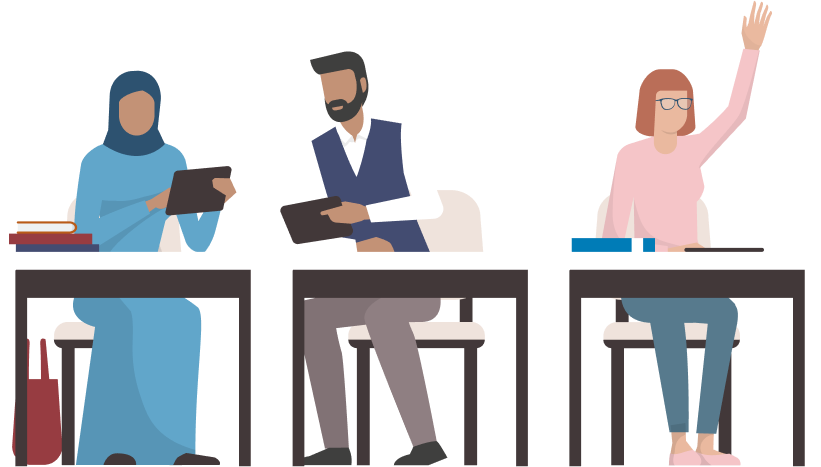
MBO Onderwijsroute ROC
Na de brugklas ga je naar een ander traject. Dit kan de Z-route, de B1 route of de onderwijsroute zijn. Je hebt met je klantregisseur afgesproken aan welk traject je meedoet. Deze uitleg gaat over de onderwijsroute die je op het MBO gaat volgen.
1.
Wat is het?
Na de brugklas begin je met het vervolg van je inburgering.
Er zijn drie routes:
1 De B1 Route
De B1-route is gericht op het leren van het Nederlands als Tweede taal (Nt2) op taalniveau B1. Je leert over de Nederlandse maatschappij, zoals de geschiedenis, het onderwijssysteem en de gezondheidszorg. Aan het einde krijg je een examen met de volgende onderdelen:
-
-
-
-
- Lezen
- Luisteren
- Schrijven
- Spreken op niveau B1
-
-
-
Slaag je voor dit examen en nam je deel aan andere verplichte onderdelen van de inburgering? Dan krijg je je inburgeringsdiploma.
2 De Z-route
Dit is een intensief traject. Het bestaat uit activiteiten die aansluiten bij wat jij kunt. Je leert de Nederlandse taal op A1 niveau of hoger. Ook leer je hoe je zelf dingen kunt regelen in Nederland. We ondersteunen je bij het vinden van (vrijwilligers)werk of het deelnemen aan activiteiten die passen bij wat jij kunt. Als je de Z-route volgt, krijg je geen inburgeringsexamen. Wel zijn er verplichte onderdelen en volg je 800 uur lessen en loop je 800 uur stage bij een organisatie in Tilburg. Als je dat hebt gedaan, heb je voldaan aan de inburgeringsplicht.
3 De Onderwijsroute
Je start met deze route als na een toets blijkt, dat een vervolgopleiding je doel is.
Wat is de mbo onderwijsroute?
Dit is de voorbereiding op een MBO-opleiding. Je volgt deze op het ROC. Deze bestaat uit:
- Nederlandse les (Nt2)
- Engelse les
- Rekenen
- Studievaardigheden
- Loopbaanbegeleiding
- Kennismaking met de Nederlandse Maatschappij (KNM)
- Een stage. De stage kan via het netwerk van het ROC. Je kunt ook zelf met een voorstel komen.
2.
Wat is het doel?
We bereiden je voor op een goede start op het MBO.
3.
Hoe lang duurt het?
De opleiding duurt twee jaar.
Het eerste jaar ziet er zo uit:
- Nederlands |19 weken 5 keer 3 uur per week + 19 weken 4 keer 3 uur per week
- Engels | 19 weken | 2 keer 2 uur per week | begint in de tweede helft van het jaar
- Rekenen | 19 weken | 2 keer 2 uur per week | begint in de tweede helft van het jaar
- Kennis Nederlandse Maatschappij | 19 weken 1,5 uur per week | begint in de tweede helft van het jaar
- Loopbaanoriëntatie | 19 weken | 1,5 uur per week
- Studievaardigheden | 19 weken | 1,5 uur per week
- Stage lopen | 19 weken 4 tot 8 uur per week | begint tweede helft van het jaar.
Je gaat stage lopen bij een organisatie die aansluit bij je interesse en je toekomst.
- Coaching en begeleiding (wekelijks een kwartier per cursist)
Het tweede jaar ziet er zo uit:
- Nederlands | 38 weken | 4 keer 3 uur per week
- Engels | 38 weken | 2 keer 2 uur per week
- Rekenen |38 weken | 2 keer 2 uur per week
- Stage | 38 weken | 4 tot 8 uur per week
- Studievaardigheden | 19 weken | 1,5 uur per week
- Loopbaan oriëntatie | 19 weken | 1,5 uur per week
- Coaching en begeleiding | wekelijks 0,25 uur
Je hebt in beide jaren een volle leer-/werkweek.
4.
Voor wie is het?
Voor statushouders die klaar zijn met de opstartklas en de brugklas. Uit de toets moet blijken dat deze route het beste bij jouw mogelijkheden aansluit. Je mag maximaal 28 jaar oud zijn. Wil je na je inburgering een BBL-opleiding (mbo opleiding in combinatie met werk) doen? Dan kun je ook aan deze opleiding meedoen. Je kunt hiervoor ook de B1-opleiding volgen.
Om mee te doen aan deze opleiding heb je dit nodig:
- Je moet voldoende scoren op taalleerbaarheid. Dat wil zeggen hoe goed je in staat bent om een nieuwe taal te leren.
- Je moet het Engels voldoende beheersen (MBO 4 niveau)
- En heel belangrijk: je moet gemotiveerd zijn, tijd én ruimte hebben om te studeren.
Ben je 30 jaar of ouder? Kijk dan wat er mogelijk is via het levenlang-leren-krediet.
5.
Hoe ziet het contact eruit?
Je gaat 5 dagen per week naar school. Je krijgt ook huiswerkopdrachten. Je bent dus echt een volle week aan de slag. Je hebt een eigen studiebegeleider. Met hem/haar zoek je een stageplek uit die zoveel mogelijk aansluit bij jouw interesses en waar je toekomst in ziet.